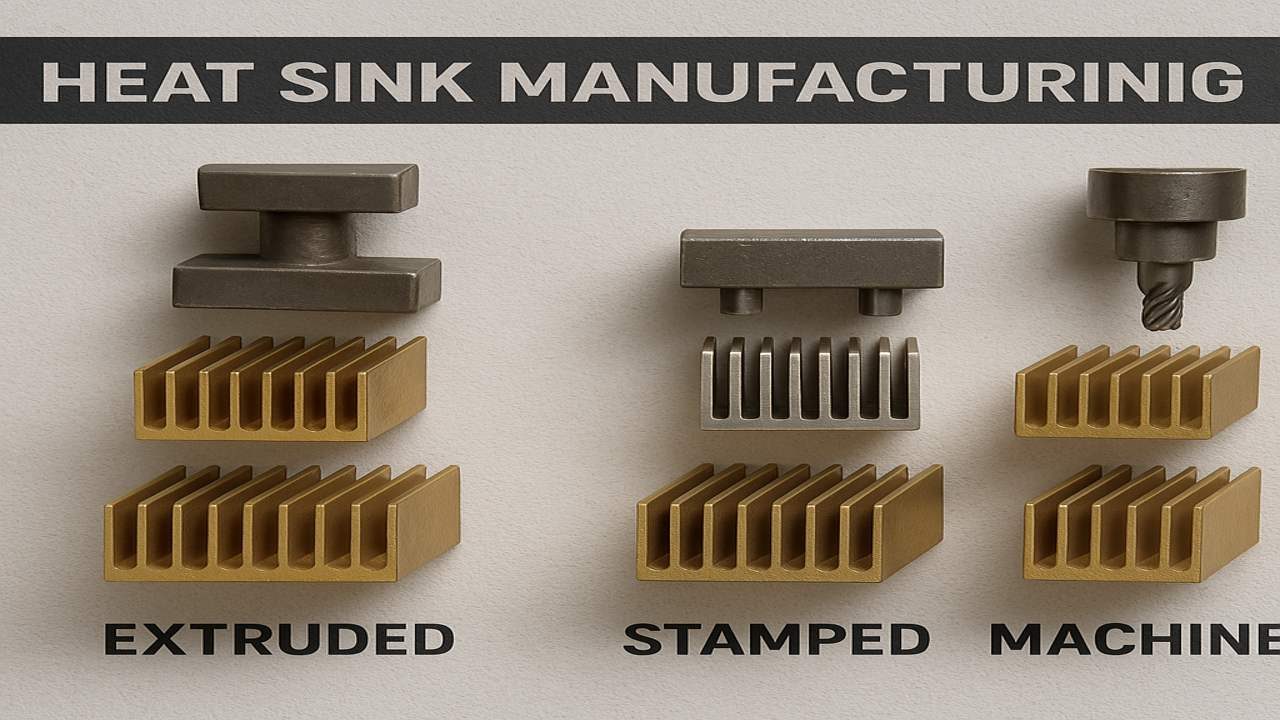The heat sink is considered a worthy cooling solution for electronic components. It assists in maintaining temperatures and improves performance without criticalities. Copper and aluminum have made the heat sink a strong thermally conductive source. It can be used in various low-end to high-end cooling tasks.
The term low to high-end tasks here refers to the standards a heat sink owns. These standards then refer to different manufacturing methods. Finally, what are the manufacturing methods of a heat sink? How does each method impact performance, reliability, and cost factors? Let’s dive into the discussion and check it in detail.
Understanding Heat Sink
“A heat controlling device used in electronics to dissipate the heat generated by components”. It further includes a combination of base-plate, heat-pipes, and cooling fins. There are three known types of heat sinks: passive, active, and hybrid heat sinks. Heat sinks are commonly utilized in electronics, CPUs, GPUs, and LEDs.
– Key Features:
- Heat Sink provides optimal thermal conductivity.
- Heat Sink provides better airflow because of surface area.
- Heat Sink features both passive & active cooling options.
- Heat Sink is an affordable cooling solution.
- Heat Sink comes in different sizes and shapes.
- Heat Sink requires less maintenance.
Manufacturing Material
- Copper: It delivers a thermal conductivity range value of 400 W/mK.
- Aluminum: It delivers a thermal conductivity range value of 237 W/mK.
- Graphite: It delivers a thermal conductivity value of 168 W/mK.
- Diamond: It delivers a thermal conductivity value of 2200 W/mK.
Heat Sink Manufacturing Methods
1: Extrusion
Extrusion is the most common and cost-effective method of manufacturing a heat sink. In this method, copper and aluminium are heated to a required temperature and passed through a forced die. Such passing turns the materials into relevant lengths and sizes. Finally, a cut-out is performed to get the heat sink into the required shape and dimension.
Benefits:
- Cost Effective
- Optimal Thermal Conductivity
- Ligh Weight
Applications:
- Consumer Electronics and LED Lights
2: Die Casting
In the die casting method, liquid (molten) metals like aluminium and zinc are poured into a steel die/mold. The steel die/mold is set to specific shapes, sizes, and thickness. After cooling down under pressure, it turned into a solid form and required patterns. This manufacturing method suits scenarios where complex patterns are demanded.
Benefits:
- Accurate Patterns/Dimensions
- Handles Large Production Levels.
Applications:
- Industrial Machinery and Electrnoics
3: CNC Machining
Computer Numerical Cutting (CNC) is a manufacturing method in which a machine cuts and shapes heat sinks from a large piece of metal. There is no chance of errors or mistakes in CNC machining. Moreover, this method allows customized designs of every size, dimension and thickness. It also supports both low-production and high-production operations.
Benefits:
- Meets Accuracy and Complexity
- Design Compatibility & Flexibility
Applications:
- Defense System and Medical Industry
4: Forging
Forging is another famous method of manufacturing heat sinks. Here, metal (copper/aluminium) is compressed under heavy pressure. Relevant tools/machinery like dies, presses, and hammers are used to shape and compress metal. This results in a heavy mechanical strength and the ability to perform high-end cooling tasks.
Benefits:
- Compatible with High-End Cooling Tasks
- Provides Optimal Thermal Conductivity Range
Applications:
- Automotive and Defense Industry
5: Skiving
The skiving method involves cutting and creating heat sink fins from a piece of metal (copper and aluminium). An automated sharp blade machine is used for this purpose. The skiving method usually requires a heavy investment. Low-end tools can’t cut the fins into thin dimensions (0.25 to 0.8mm).
Benefits:
- Better Surface Area
- Good Thermal Conductivity
- Quality Cooling Fins
Applications:
- Telecommunication Department
6: Stamping
The manufacturing of heat sinks using the stamping technique involves cutting metal sheets into required shapes and dimensions using dies. The created fins are then attached to the base of heat sinks or heat pipes. Stamping is usually preferred where heat sinks are required for low to moderate-level cooling tasks.
Benefits:
- Supports Low Productions Units
- Beneficial for Cutting Thin-Sized Fins
Applications:
- Consumer Electronics and LED Lights
JiuJu Heat Sinks
You know what? We own the title of manufacturing quality heat sinks. Whether it’s a matter of low-end or high-end cooling tasks. JiuJu has a variety of such heat sinks that offer optimal thermal conductivity, quality build material, required dimensions, and thin fins.
Moreover, we also have expertise in manufacturing quality thermal interface materials. Our highlighted TIMs are Thermal Pads, Thermal Paste, Thermal Gel, and Thermal Adhesives. JiuJu’s manufactured TIMs are used by more than 500+ clients around the globe.
We offer wholesale and discounted rates, which are comparatively lower than the market rates. Similalry, bulk-buyers can get many other benefits and perks. Our storage and delivery system are pretty transparent and up to the required standard with no notable complaints.
If you are looking for a reliable platform to buy heat sinks and other TIMs. JiuJu is here with its quality products and services. Contact our customer support to get a quotation. Signing a contract with JiuJu will bring innovation to the cooling of components.
Bottom Line
Choosing a specific heat sink manufacturing method solely depends upon the cooling requirements. Manufacturing methods, including skiving and CNC machining, are suitable for high-end tasks. Similarly, extrusion and stamping manufacturing methods are relatively known for low to medium-level cooling tasks.
In the end, we can say that every manufacturing method has its importance. One can never deny the solid contribution of heat sinks in dissipating heat and maintaining performance. Heat sinks are a reliable, budget-friendly, and long-term solution.
Tired of testing different TIMs? Don’t worry; check the top-quality thermal management products by JiuJu.





